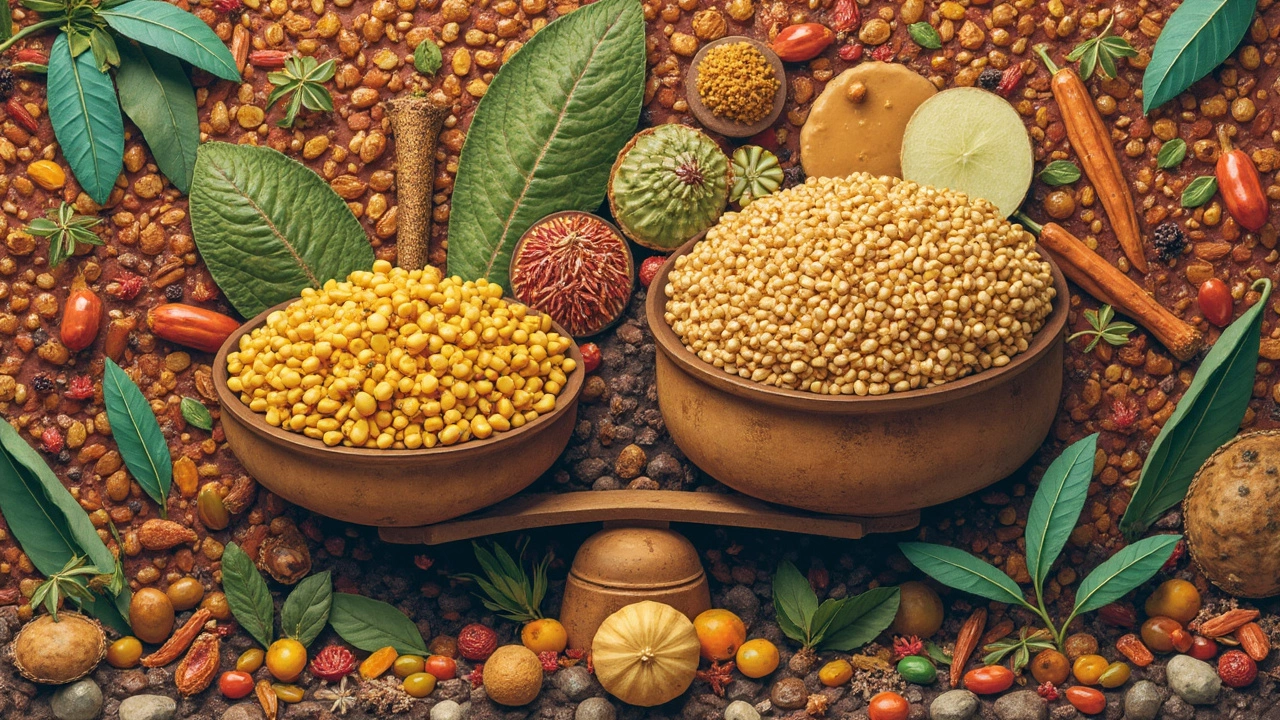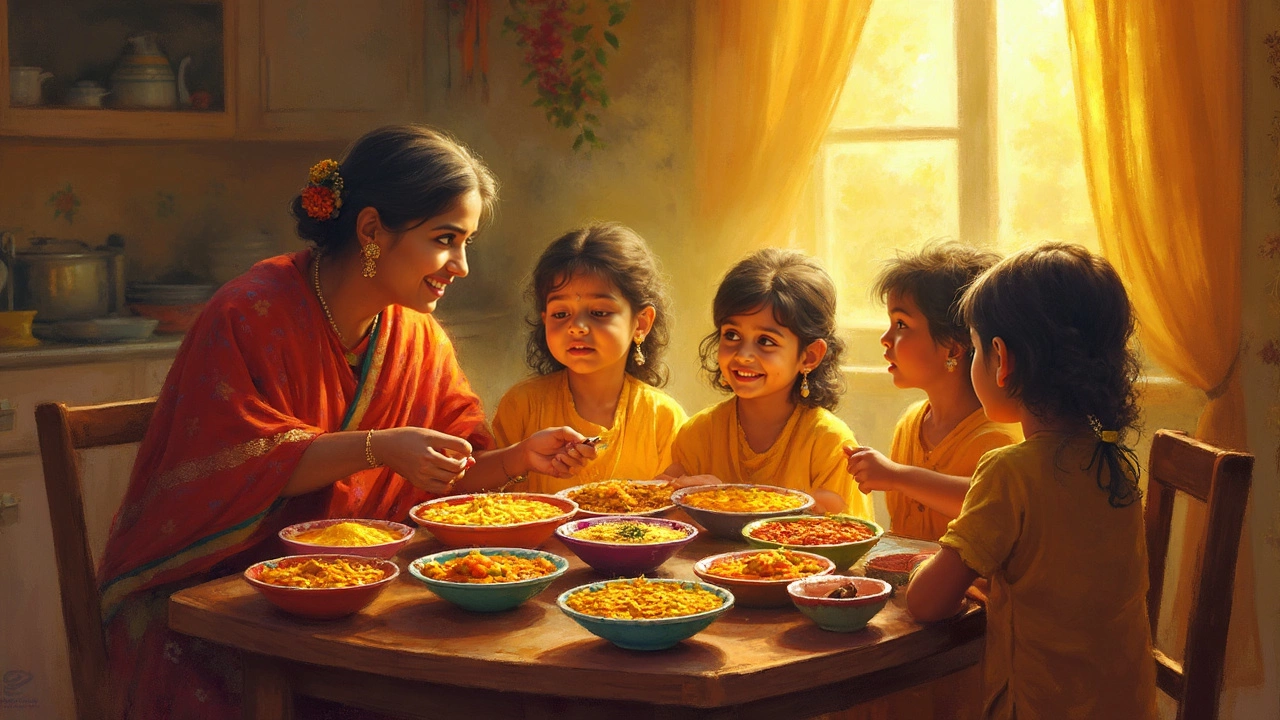21 Mar 2025
- 0 Comments
Dal, which is essentially lentils, is an undeniable favorite in lots of kitchens. It's loaded with protein and rightly claimed as a superfood, especially for vegetarians. But can there be too much of a good thing? You bet!
Having dal every day might not always sit well with our bodies. Sure, it's healthy, but like all foods, it's not perfect on a constant loop. Imagine relying too heavily on one type of food. Things like excessive fiber can mess with your stomach, leading to those not-so-pleasant runs to the bathroom.
And that's just the start! Dal has compounds that, in large amounts, might throw a wrench in your body's ability to absorb minerals. Plus, often consuming it might lead to issues like gas and bloating—a discomfort that can sneak up on you when you're least expecting.
Thus, understanding how dal fits into a balanced diet is crucial. It's all about maintaining a healthy variety while enjoying what you eat. Keep scrolling for some practical insights and avoid turning your love for dal into a digestive drama!
- The Nutritional Powerhouse: Dal Basics
- Consequences of Overconsumption
- Digestive Discomforts
- Nutrient Imbalance Concerns
- Gas and Bloating: The Hidden Issue
- Balancing Dal in a Healthy Diet
The Nutritional Powerhouse: Dal Basics
Dal holds a special place in many kitchens, especially in South Asian cultures. It's an affordable, versatile, and nutritious option that can spruce up any meal. But what makes dal such a nutritional heavyweight? Let's dig into what a humble bowl can offer.
First off, dal is rich in proteins. It's often hailed as the top choice for vegetarians trying to pump up their protein intake. Protein is crucial because it plays a vital role in muscle building and repair, not to mention overall body function.
Aside from that, dal is packed with essential vitamins and minerals. It's a sneaky way to get your daily dose of folate, iron, and magnesium. Folate is important for cell growth, iron keeps your energy levels up by aiding in oxygen transport, and magnesium helps with muscle function and mental focus.
Now, you might be thinking about fiber. Yep, that’s right—not only is dal a protein champ but it's loaded with dietary fiber too. Fiber is the secret sauce for a happy digestive system because it keeps things moving smoothly and can even contribute to lowering cholesterol levels.
The Types of Dal
There's more to dal than just one type. You've got your red lentils, yellow pigeon peas, green mung beans, and black grams, just to name a few. Each with its unique taste and slightly different nutrient profiles. For instance, moong dal is light and easy to digest, making it perfect for a quick lunch fix!
While generally low in fat, lentils like urad dal might pack a bit more if you're watching your fat intake. But hey, variety is the spice of life, right?
| Type of Dal | Protein (per 100g) | Fiber (per 100g) |
|---|---|---|
| Red Lentils | 9g | 8g |
| Yellow Pigeon Peas | 8g | 6g |
| Green Mung Beans | 7g | 7g |
So, whether you're a vegetarian hunting for dal diet hacks or simply someone who's curious, understanding the basic nutritional layout of dal can help you make informed decisions about how to work it into your meals effectively. Just remember, moderation is key to enjoying it minus any downsides!
Consequences of Overconsumption
While dal is a hero in the protein world, going overboard isn't always the best idea. Eating too much of it might unleash some unexpected, not-so-pleasant surprises for your body.
Digestive Dynamics
The high fiber content in dal is a blessing and a curse. While fiber is good for keeping you regular, an overload can lead to an upset stomach, diarrhea, or even constipation. Your body's like, “Whoa, slow down!” It's key to balance it with other foods to keep that digestive train running smoothly.
Nutrient Absorption Woes
Dal, in its entirety, contains certain compounds like phytates that can mess with how your body absorbs essential minerals like iron and zinc. If you're constantly munching on dal, you might end up short of these vital nutrients, even if it seems counterintuitive.
The Great Gas Debate
One common ailment of eating too much dal is the buildup of gas. Yep, fiber-rich foods like dal can lead to bloating and discomfort. Nobody wants that uneasy feeling lingering around after a meal. Moderation really is the key here.
| Potential Issue | Effect |
|---|---|
| Fiber Overload | Digestive discomfort |
| Phytates | Reduces mineral absorption |
| Excess Fiber | Gas and bloating |
So while you might feel like a rockstar including dal every single day, remember balance is your BFF. Mixing things up with different proteins and keeping an eye on serving sizes could save you a lot of digestive trouble.
Digestive Discomforts
Alright, let's chat about the not-so-fun side of eating dal daily—digestive discomforts. Despite being a nutritional powerhouse, fixating on dal day in and day out might lead to some tummy troubles. We're talking gas, bloating, and even the occasional upset stomach.
So, what's the science behind these uncomfortable moments? Well, dal is high in fiber, which is generally great for you. However, when consumed excessively, it can overload your digestive system. If you've ever felt like your belly transformed into a balloon after a dal-heavy meal, the fiber is probably behind it.
Why Fiber Overload Happens
Fiber isn't digested in the stomach; instead, it heads to the intestines. Once there, it ferments and can produce gas, leaving you feeling bloated or uncomfortable. The high fiber content is precisely why dal is so filling, but it's also why eating too much may turn your digestive tract into a turbulent mess.
Phytic Acid: The Hidden Element
An often overlooked factor is phytic acid, a compound found in lentils which can sometimes hinder the absorption of minerals. When consumed in moderation, it's typically not an issue. But when dal is a daily affair, those mineral blockades can stack up.
Tips to Avoid Discomfort
- Moderation is your friend. Vary your legume intake with a variety of beans.
- Soak dal before cooking; it reduces phytic acid levels and makes it easier on your digestion.
- Introduce ginger or garlic into your recipes. They're known for helping mitigate bloating.
- Chew your food well. It sounds basic, but it actually helps in breaking down the fiber more effectively.
By being mindful of these tips, you can keep enjoying dal without the unpleasant digestive interruptions. Keep your diet varied and your gut will thank you!

Nutrient Imbalance Concerns
All this talk about dal being super nutritious might have you reaching for it every day, but hold up. Too much of it can actually throw your diet off balance. While protein is the star of the show in dal, it's not the only nutrient you need.
The Mineral Absorption Problem
Here's the catch: dal contains compounds called anti-nutrients, such as phytic acid. Sounds intense, right? These pesky little things can bind to minerals like iron, zinc, and calcium, making it hard for your body to absorb them. So, even if you’re eating these nutrients, your body's kind of like, "Nah, I’m good, thanks."
Getting Enough Variety?
Eating dal daily means you might not be getting enough variety in your diet. Think about your taste for adventure! Our bodies need a mix of nutrients from different foods to feel their best. So if dal is the star every single day, other beneficial foods like leafy greens, nuts, and seeds might be getting benched.
- If you love your dal, don’t worry! Consider mixing it up a bit.
- Once or twice a week, swap dal with chickpeas, beans, or tofu.
- Add different vegetables and whole grains to each meal to keep things colorful and nutritious.
It's all about balance! Enjoy dal's benefits but remember to team it up with a diverse cast of nutrients for a healthier, happier you.
Gas and Bloating: The Hidden Issue
Even though dal is a nutritional powerhouse, consuming it every day might come with some digestive downsides. One of the most common issues is the infamous gas and bloating, which can be quite uncomfortable and even embarrassing.
So, why does dal cause gas? It's all about the high fiber content, which, while good for digestion, can also lead to bloating. Fiber is great because it helps keep things moving through your digestive tract, but not everyone's gut handles it the same way.
FODMAPs and Dal
Dal possesses certain types of carbohydrates known as FODMAPs (Fermentable Oligo-, Di-, Mono-saccharides And Polyols). These can be hard to digest, especially for those with sensitive stomachs or IBS. FODMAPs are easily fermented by gut bacteria, leading to gas production.
The Phytic Acid Effect
Another aspect to consider is phytic acid, naturally found in lentils. While it has antioxidant properties, high amounts can bind minerals in the gut, disrupting nutrient absorption and potentially leading to more bloating.
Practical Tips to Reduce Gas
- Soak Dal Overnight: This can help reduce phytic acid and make it easier on your tummy.
- Cook Thoroughly: Well-cooked dal breaks down fibers, diminishing gas production.
- Introduce Slowly: If your body isn't used to high fiber, introduce dal into your diet slowly to allow your gut to adapt.
- Add Spices: Cumin, ginger, and turmeric can aid digestion and reduce bloating.
By understanding these factors and making some simple tweaks, you can still enjoy dal without the worry of extra gas. It's all about balance and listening to your body.
Balancing Dal in a Healthy Diet
Now, you might be thinking, "So how do I keep enjoying my dal without overdoing it?" The key here is variety. Let's talk about mixing up your meals while keeping dal as the star player.
Mix Up the Legumes
Consider rotating different legumes throughout the week. Chickpeas, black beans, and kidney beans are all great choices. This keeps you from getting stuck in a dietary rut and ensures you're getting a broader spectrum of nutrients and flavors.
Watch the Portions
Eating dal doesn't mean you need a mountain on your plate. A standard serving size is about half a cup of cooked lentils. Stick to this, and pair it with veggies or salads to make your meal more balanced.
Complement with Whole Grains
Pairing dal with whole grains like brown rice or quinoa boosts the protein quality in your meal. This combination provides all the essential amino acids your body needs. Plus, whole grains offer additional fiber and minerals.
Add Colorful Veggies
Next time you cook dal, throw in some seasonal veggies. Carrots, spinach, or bell peppers add both color and nutrition to your dish. This not only makes your meal more appealing but also boosts its nutritional profile.
- Carrots: Rich in beta-carotene for eye health.
- Spinach: Loaded with iron and vitamins.
- Bell Peppers: High in vitamin C.
Moderation is Key
Like with anything in life, balance is vital. Incorporate other protein sources, like tofu or eggs, to keep meals interesting and nutritionally complete.
The Bottom Line
So keep enjoying your dal, but remember it's all about mixing things up and keeping it colorful and varied!
